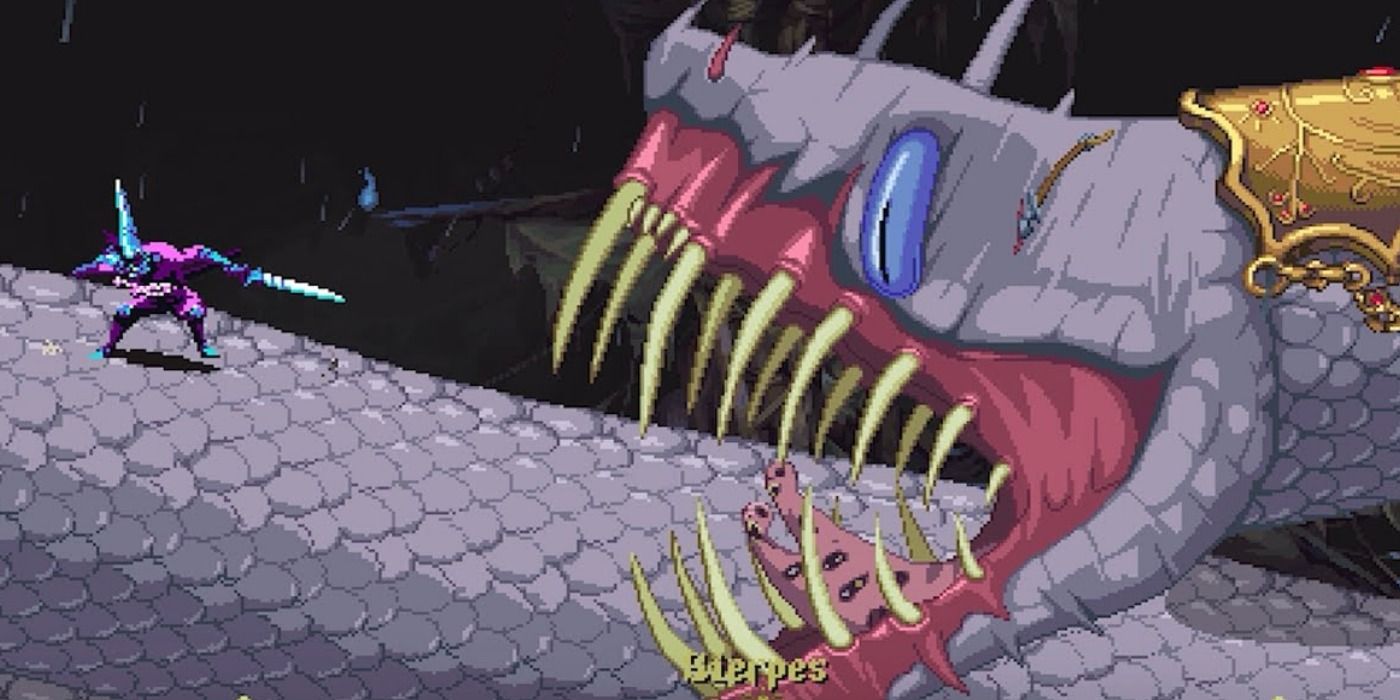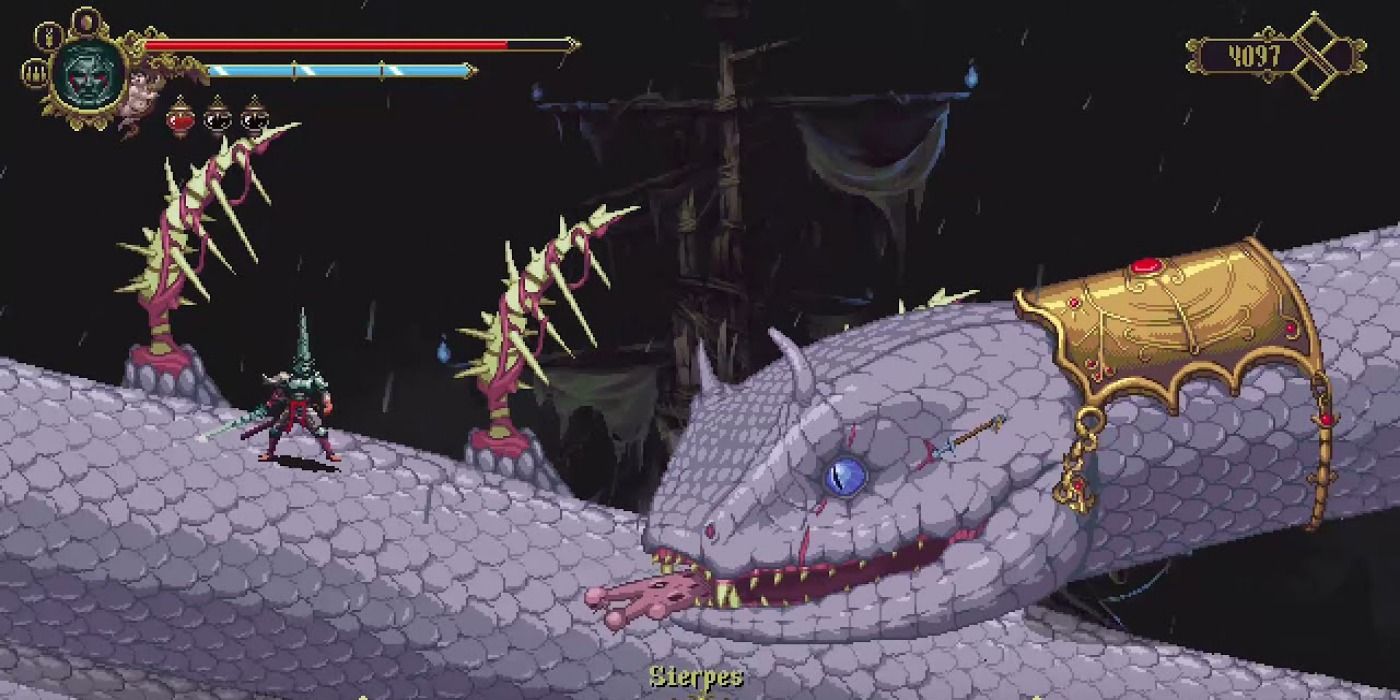
Blasphemous: Wounds of Eventide introduces the giant snake boss Sierpes, whose fight leans more heavily towards the style of Dark Souls than other bosses in the game. Sierpes can be found on the far top left of one of the DLC's new areas, Mourning and Havoc. The closest Prie Dieu is located down a releasable ladder from the boss area entrance. Players should be careful not to take damage from the lightning lines that crisscross the ladder before entering the area.
Sierpes possesses one of the golden eyes of an exiled member of the Holy Guardian Visages. To achieve the true ending, the player must retrieve one eye from Sierpes and the other from Isidora, Voice of the Dead. The pair were featured in the Wounds of Eventide trailer that confirmed a sequel coming in 2023. While Isidora requires collecting a majority of the bone trinkets and returning them to the ossuary, Sierpes can be confronted as soon as the Bridge of the Three Calvaries is crossed by following the path directly right through the Ferrous Tree, the Patio of Silent Steps, the Tree of Three Words, and the Mother of Mothers, to an elevator with goes all the way down the map the Mourning and Havoc.
Sierpes can be a hard fight in Blasphemous, especially for players on New Game+, because it requires the player to learn all the attacks and survive long enough to wear the huge monster down, similar to the Guardian Ape in Sekiro: Shadows Die Twice. To this end, the Amber Eye rosary bead can be very helpful because many of Sierpes' attacks are lightning-based. There are three phases to the fight, which trigger when Sierpes loses one-third of its health, and then two-thirds. Its most devastating attack type is a charging bite which can be a near-instant kill, but there are several other types the player will have to memorize, including patterned lightning ball attacks, a targetted lightning ball attack, a homing lightning line attack, homing sphere attacks, and moving and stationary spine attacks.

Sierpes is a war of attrition in Blasphemous: Wounds of Eventide. Because of high health and heavy attacks, trading blows is not a viable strategy. Instead, players should try to avoid damage as much as possible and get in hits when there are moments of relative safety, which means knowing its move set is critical. Having upgraded Bile Flasks with Quicksilver to increase the player's available healing will be useful because few attacks have the strength to outright kill the player. Sierpes is only vulnerable on its tongue, so there is no point attacking when its mouth is closed. The safest time to attack is after a bite attack when Sierpes pulls its head back leaving its tongue out for a few seconds with no chance of danger. Hits can also be gotten in at the beginning of the home sphere attack, the moving spine attack, and the pattern lightning ball attack. The player will want to stay close, but not inside of Siepres' mouth. If it closes on the player, they will take damage and be knocked down, so staying at the edge of the player's attack range is a good place to be.
Like the Amanecida of the Golden Blades in Blasphemous, Sierpes attacks are difficult or impossible to block, but most of the first phase attacks are simple to evade, except the charging bite and the line lightning attack. If the player is too close to Sierpes' mouth or in an attack animation when it charges, they will be unable to get out of the way in time. The Young Masons Wheel rosary bead can make the difference here. Conversely, if they are too close to Sierpes when the lightning line attack starts, it will come on the right side instead of between Sierpes and the player, making it unavoidable and doing multiple instances of damage. Good positioning is a prerequisite for this fight, and it won't be easy, unlike some oversized Dark Souls bosses. There is also a glitch in the homing sphere attack where if the player is close to Sierpes' mouth and gets hit by a sphere, they will get stuck prone on Sierpes' jaw until it closes it. They won't take further damage during this time, but it can put the player out of position when they get up.
The start of Sierpes' second phase is shown by a black and white flash on the screen. In this phase, Sierpes gains the ability to attack from the right side as well, and there is a wind effect that can move the player, similar to in the Graveyard of the Peaks. The addition of environmental danger, a hallmark of difficult Dark Souls bosses, is the major difficulty increase in phase two. It gets an additional moving spine attack and a stationary spine attack, both of which can only be made when its head is on the right and it is about to launch a bite attack. Both can be dodged under, though the wind may blow the player into them. The number of homing spheres goes up from two to three, and there is a greater variety of patterned lightning attacks, which provide good opportunities for the player to deal damage.
The final phase is again telegraphed by a flash of black and white. The player will likely be running low on health and switching to Blasphemous' Token of Appreciation from Alms for the Church and Light of the Lady of the Lamp rosary beads can provide a small boost to finish the job. The most important thing to remember in this phase is to resist the urge to get that one more extra hit that every Souls player feels. Steady progress and caution are the way to victory. The wind increases, making it more difficult to avoid stationary attacks. Another homing sphere is added, but the third phase is largely a continuation of the second.
As with many bosses in Blasphemous, players may encounter Sierpes before they are ready to face it. As long as they don't fight Crisanta before beating both Sierpes and Isidora, Voice of the Dead, there's no reason to rush the fight. If players struggle, coming back to Sierpes later may be the answer, even for veteran players.
Blasphemous: Wounds of Eventide is available on PC, Mac, Linux, PlayStation 4, Xbox One, and Nintendo Switch.
Comments
Post a Comment